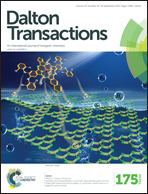A ZrNiAl related high-pressure modification of CeRuSn†
Abstract
Monoclinic CeRuSn with its own structure type transforms to a high-pressure modification at 11.5 GPa and 1470 K (1000 t press, Walker type module). The structure of the high-pressure phase was refined from X-ray single crystal diffractometer data at room temperature. The HP-CeRuSn subcell structure adopts the ZrNiAl type: P![[6 with combining macron]](https://www.rsc.org/images/entities/char_0036_0304.gif) 2m, a = 751.4(3) and c = 394.6(2) pm, wR2 = 0.0787, 310 F2 values and 15 variables. The Ru2 atoms within the Sn6 trigonal prisms show a strongly enhanced U33 parameter. Weak satellite reflections indicate a commensurate modulation: (3 + 1)D superspace group P31m(1/3,1/3,γ)000, a = 751.4(3) and c = 394.6(2) pm, γ = −1/3, wR2 = 0.0786, 1584 F2 values, 32 variables for the main reflections and wR2 = 0.3757 for the satellites of 1st order. A description of this new superstructure variant of the ZrNiAl type is possible in a transformed 3D supercell with the space group R3m and Z = 9. The driving force for formation of the modulation is strengthening of Ru–Sn bonding within the comparatively large Ru@Sn6 trigonal prisms. Electronic structure calculations point to an almost depleted Ce 4f shell. This is substantiated by temperature-dependent magnetic susceptibility data. Fitting of the data within the interconfiguration fluctuation model (ICF) resulted in cerium valences of 3.41 at 10 K and 3.31 at 350 K. Temperature dependent specific heat data underline the absence of magnetic ordering.
2m, a = 751.4(3) and c = 394.6(2) pm, wR2 = 0.0787, 310 F2 values and 15 variables. The Ru2 atoms within the Sn6 trigonal prisms show a strongly enhanced U33 parameter. Weak satellite reflections indicate a commensurate modulation: (3 + 1)D superspace group P31m(1/3,1/3,γ)000, a = 751.4(3) and c = 394.6(2) pm, γ = −1/3, wR2 = 0.0786, 1584 F2 values, 32 variables for the main reflections and wR2 = 0.3757 for the satellites of 1st order. A description of this new superstructure variant of the ZrNiAl type is possible in a transformed 3D supercell with the space group R3m and Z = 9. The driving force for formation of the modulation is strengthening of Ru–Sn bonding within the comparatively large Ru@Sn6 trigonal prisms. Electronic structure calculations point to an almost depleted Ce 4f shell. This is substantiated by temperature-dependent magnetic susceptibility data. Fitting of the data within the interconfiguration fluctuation model (ICF) resulted in cerium valences of 3.41 at 10 K and 3.31 at 350 K. Temperature dependent specific heat data underline the absence of magnetic ordering.


 Please wait while we load your content...
Please wait while we load your content...